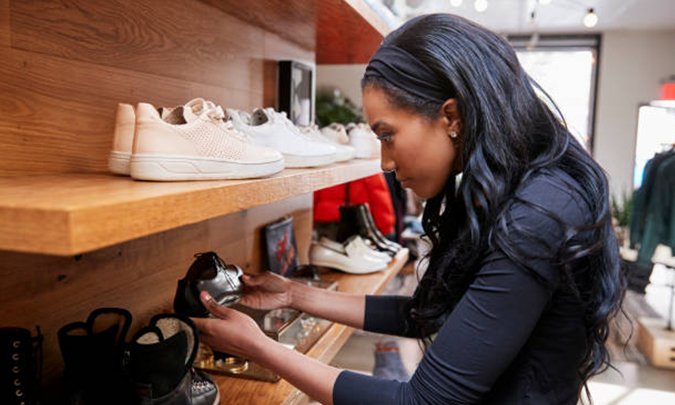
Published on August 22, 2023
Read Time: 5 Minutes
Three Things to Know
- Comfort and fit are the most important factors to consider when choosing shoes. Shoes should feel good instantly; you should not have to break them in.
- Wearing the wrong shoes can lead to a variety of foot problems, such as heel and arch pain, hammertoes, bunions, nerve pain, ingrown toenails, blisters and sores.
- When shopping for a good pair of shoes, look for a stable sole, a firm heel counter and lace-up closure.
According to a 2018 study published in the Journal of Foot and Ankle Research, between 63% and 72% of people wear the wrong size of shoes. Beyond shoe size, many people simply choose shoes that are unsupportive. Chris Johnson, DPM, a board-certified podiatrist at Phelps Health, answers commonly asked questions on footwear, a topic he is passionate about.
What are the most important factors to consider when choosing shoes?
When selecting a shoe, consider comfort and fit. It’s easy to get hung up on style and look, but shoes should fit and feel good immediately after putting them on. Resist the urge to say, "Oh, they will break in and feel better.” While some shoes may fit better in time, most often this is not the case.
What are the potential risks or problems with wearing shoes that are too small or too big for your feet? How much "breathing room" should shoes have?
Shoes that are too tight will cause your toes and other bony areas of your feet to hurt, and over time, will result in sores. Wearing shoes that are too big can be just as uncomfortable. Our feet can slip and slide around in them, causing excessive friction which may result in painful blisters. Shoes that are too loose also can cause feet to ache, from a lack of support.
A good standard when trying on shoes is to make sure you have a thumbs-width of space while standing, from the longest

toe to the tip of the shoe. Another way to make sure a shoe will fit your foot properly is to stand up and make a tracing of your foot on a piece of paper. When you’re shoe shopping, take the factory insole out of the shoe and place it on your foot tracing. If you see your “foot” sticking out, then you will know that the shoe will be too short or too narrow.
What are some common foot problems that can be caused by wearing the wrong shoes?
Wearing the wrong shoes can lead to heel and arch pain, hammertoes (an unusual bend in the middle joint of a toe), bunions (where the tip of your big toe shifts towards the smaller toes), nerve pain, ingrown toenails, blisters and sores, as well as overall muscle aches and pains.
What type of footwear would you recommend for someone with specific foot conditions such as flat feet, high arches or plantar fasciitis?
I recommend running shoes most often, particularly Asics and Brooks. They are not just for runners, but they generally have all the bells and whistles built into them for support and control of your feet. Certain brands have specific shoes for people with pronation (flat feet) or supination (high arches). You should be able to search for shoes tailored for specific conditions online. Remember, comfort and support are key.
What are orthotics? Do I need them?
Orthotics are devices that are placed inside the shoe in place of the factory insole. They can be purchased over the counter or custom-made for your feet. When you remove the factory insole from a shoe and look inside, you’ll notice that arches are not built into shoes anymore, as everyone's feet are different. I recommend putting some type of a device inside the shoe for additional support. Custom orthotics are designed to fit your specific foot. You can choose between a functional or an accommodative orthotic. Functional orthotics give more support and control to help your feet better and function in a more normal position. Accommodative orthotics are generally made from a foam impression and are more cushion-like, similar to diabetic insoles.
Do I need arch supports?
Not everyone needs orthotics or arch supports, assuming your shoes fit properly and feel good. However, adding a quality insole to a good shoe will lead to even better comfort.
Can you buy a quality pair of shoes from a discount store, or do you need to buy name-brand shoes?
Unfortunately, when it comes to shoes, you get what you pay for, especially with running or athletic shoes. Generally, the higher the price, the more features the shoes have built into them for support and comfort. I tell patients to find the highest-priced shoe that is on sale or look to last year's models for big discounts.
What are three characteristics of quality shoes?
- A good stable sole: You should not be able to fold your shoe up like a pretzel; a shoe that does this is unstable and offers no support.
- The heel counter (the area that surrounds the heel) should be nice and firm; you should not be able to pinch it from side to side easily.
- Lace-up shoes are more supportive than Velcro shoes.
How often should I replace my shoes?
Shoes should be replaced anywhere from 6 months to 1 year, depending on how much you are wearing them and their condition. When you replace your shoes, this is a good time to also purchase a new over-the-counter insole. Custom orthotics should last 5-7 years.
Can you share any hygiene tips to get rid of or avoid foot odor?
Keeping your shoes clean is important, as they can harbor bacteria and fungus. Washing your shoes frequently will help as long as the fabric allows for it. You may want to consider spraying new shoes with a water repellant, which will help keep your feet drier and the shoes will be easier to clean. If the insole is removable, take it out to dry. You also can spray your shoes with a disinfectant spray like Lysol, which will cut down on the bacteria that cause odor and germs.
Are there any specific materials or aspects I should consider when choosing shoes, such as breathability or cushioning?
Today, most shoes are made out of a mesh material that is lightweight and breathable, making them easy to wash. Leather shoes, however, are often heavier and less breathable, making them harder to keep clean. Remember, we are all different, and there are many different brands and styles of shoes. You should look for what is most comfortable for you. I encourage you to try shoes on and walk around the store or the house. Finally, a quality pair of shoes should feel good instantly; you should not have to break them in.
Don’t Cut Corners
The next time you’re shoe shopping, keep these tips in mind. Your feet are important, and they will thank you! Learn more about podiatry at Phelps Health.